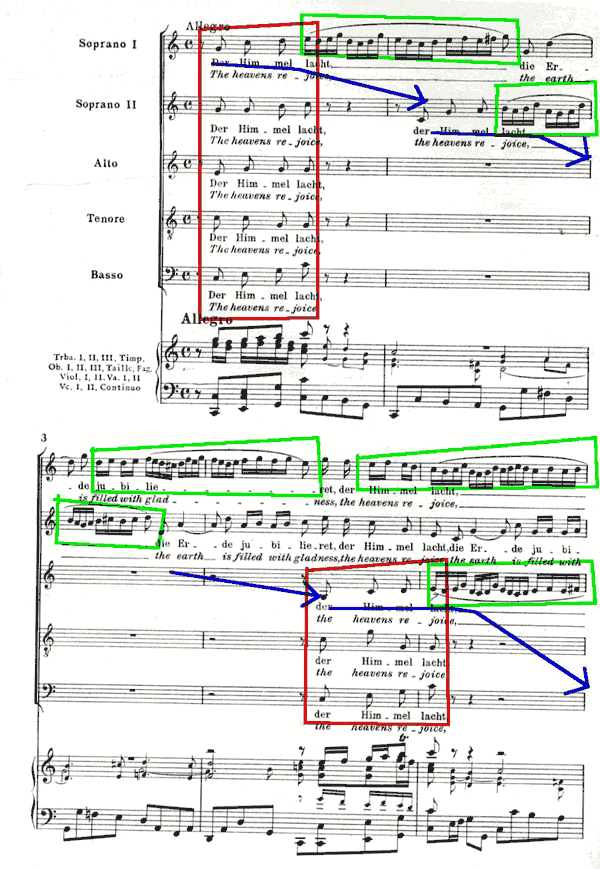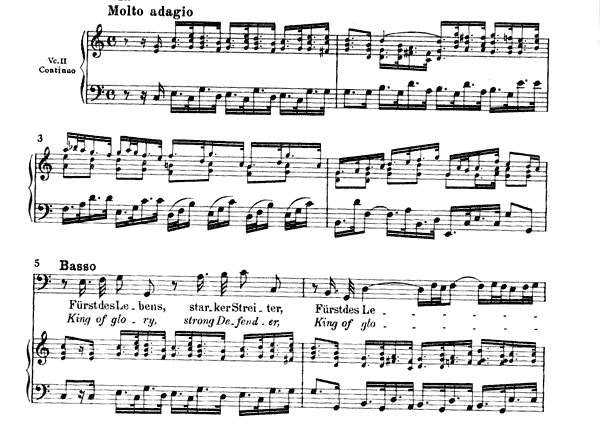Heaven laughs! The Earth rejoices!
The perfect sentiment for Easter Sunday is expressed in the title and first line of text of Bach’s Cantata BWV 31. The cantata was first performed on Easter Sunday 1715 in Weimar, and revised for two later performances (1724 and 1731) in Leipzig.
The libretto was written by Salomon Franck, except for the final movement. The final movement uses the fifth verse of the chorale “Wenn mein Stündlein vorhanded ist”, written in 1560 by Nikolaus Hermann; however, the fifth verse was added posthumously. The opening sonata, the instrumental introductory movement, is full of the kind of unrelenting rejoicing Christians associate with Easter Sunday; Franck’s text, however, turns the listener to more earthly, mortal thoughts, reminding us of Adam’s fall, and of our own death.
The cantata is scored for SSATB choir, three trumpets, timpani, three oboes, taille, bassoon, strings, and continuo. Only in the first choral movement do the sopranos split, producing a five-part chorus; otherwise, the traditional SATB arrangement occurs.
The movements are summarized in the table below:
| Meter and tempo | Key | Scoring | Texture | |
| Sonata | 6/8, allegro | C major | 3 trumpets, timpani, 3 oboes, taille, bassoon, strings, continuo | Activated, ornamented, homophonic texture |
| Chorus | 4/4, allegro; brief adagio; brief allegro to close | C major; adagio is tonally unstable; C major to close | SSATB choir, full orchestra | Polyphonic, occasionally imitative, interspersed with ornamented homophony |
| Recitative | 4/4 | C major; a minor; d minor; a minor; F major; e minor | Solo bass voice, continuo | Simple recitative |
| Aria | 4/4, molto adagio | C major | solo bass, continuo | Agitated, though homophonic |
| Recitative | 4/4 | a minor; d minor; F major; G major | Solo tenor, continuo | Simple recitative |
| Aria | 4/4, moderate to fast | G major | solo tenor, strings, continuo | Homophonic with active bass line |
| Recitative | 4/4 | e minor to C major | Solo soprano, continuo | Simple recitative |
| Aria with Chorale | 3/4, moderate to slow | C major | solo soprano, oboe I, strings, continuo | Homophonic with independent obbligato oboe |
| Chorale | 4/4, moderate | C major | SATB choir; doubled by orchestra | 4-part chorale (ornamented homophonic texture) |
The sonata begins with unisons and octaves in the full orchestra, for six measures playing virtually only pitches in the C major triad. This serves as a fanfare, perhaps waking the dead after the mourning season of Lent, perhaps announcing the start of Easter Sunday services. The rest of the movement expresses the laughter of heaven, the rejoicing on earth more than adequately. Bach never returns to this same richness in the rest of the cantata; even the first movement, with the full orchestra and SSATB choir, rejoices with a bit more reserve, perhaps recalling the necessity of Christ’s death due to Adam’s original sin, and humankind’s continuing sin thereafter.
Nonetheless, the first choral movement is glorious, marked with occasional homophonic punctuations (as at the very beginning of the movement – marked in red) to bring mankind together in their expression of joy at the risen Christ. The undulating melismas (marked in green) reflect the laughter of heaven; the staggered, imitative entrances (marked in blue) demonstrate the spread of joy throughout the world; and the timpani and trumpet entrances help reinforce the total joy of the day.

Similar gestures occur throughout this movement. Later, homophonic statements in the lower four voices reflect the shouts of joy from all creation, though these statements are more ornamented. The melismas almost always extend upward, striving toward heaven. The joyous, animated music is interrupted briefly by an adagio passage, which turns towards a minor. The text shifts to Christ being freed from the grave, his prison, and perhaps Bach took this opportunity to focus on the death of Christ, rather than the resurrection, a reminder that Christ died for the sins of humankind. But the text shifts again to the resurrection, and the quicker tempo returns, as does C major and the sense of joy (not, in my opinion, as joyous as in the opening section of the piece).
Three pairs of recitatives and arias follow, as you can see in the chart above. The bass aria is sparsely scored, marked by continuous dotted rhythms in the accompaniment, and also occurring frequently in the solo voice. Some have indicated that these dotted rhythms are reminders of Christ’s scourging – as we see in “Behold the Lamb of God” or “Surely He Hath Borne Our Griefs” from Handel’s Messiah; but those movements occur in the “Christ story” prior to the resurrection. Since this cantata was written for Easter and focuses on the resurrection, it is more likely that the dotted rhythms reflect Christ’s regal position as King of Kings, Prince of Peace (Schulenberg).

The tenor aria is the only movement set in a key other than C major in the entire cantata. This is a very melodic aria, not just in the vocal part, but in the rich, active string texture which accompanies the solo tenor. The soprano aria is almost like a dance. The orchestra, with the first oboe taking the lead, introduces a lilting melody, which the solo soprano later adopts as her own (one such passage is marked in red below). The oboe I continues with this melody throughout, though never at the same time as the soprano; the effect is almost that of a duet, though the oboe seems more independent, acting almost as though the soprano is not even present. In the second half of the aria, a chorale tune (marked in blue) is subtly inserted into the orchestral accompaniment, in a range generally well below the soprano so as to keep it distinct. This anticipates the chorale to close the cantata.











































